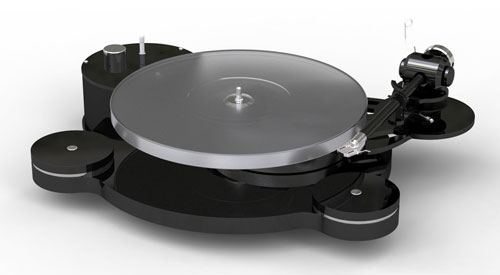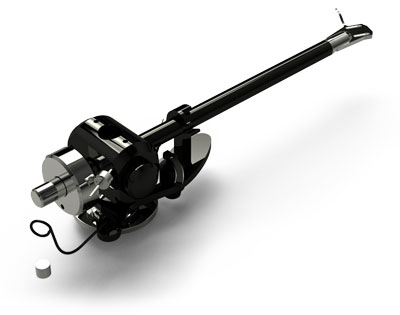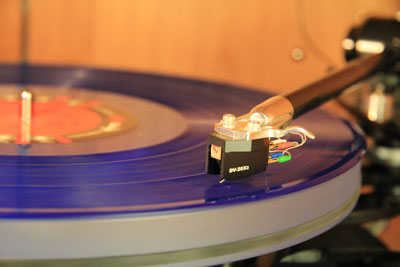| Origin Live Calypso Turntable & Encounter MK3c Tonearm |
by David McCallum

Introduction
It’s been a while since either a turntable or tonearm appeared
in the pages of The Inner Ear. One would have to go back to Vol
17 #1, printed back in 2006, to find such a review. It was with
this long absence in mind that I set out in the late winter of
2010 to discover some new vinyl electronics to audition. Given
the growing prominence of vinyl over the last few years there was
no shortage of companies to approach, and after a few months of
research the British Hi-Fi manufacturer Origin Live rose to the
top of my list.
Origin Live has been on my Hi-Fi radar for a number of years.
Either in Hi-Fi stores or while in conversation with other analogue
enthusiasts, the name Origin Live is frequently mentioned, often
during conversations about tonearms, and in particular in conjunction
with Rega products. I used to own a Rega P5 turntable and RB700
tonearm, and the common line was, “Have you considered the
Origin Live re-wiring? It makes a world of difference.” From
there the conversation would evolve into a chat about Origin Live
tonearms and, more recently, about their turntables.
In January of this year I sent an email to Origin Live. After
a few exchanges with Mark Baker, we agreed that an Origin Live
Calypso turntable matched with the Encounter MK3c tonearm would
be a good place to start.
Origin Live Encounter MK3c Tonearm
Origin Live is well known for their Rega tonearm modifications,
which began rather modestly in the mid-90s when Les Westonholme
of Avondale Audio in Derbyshire, U.K. commissioned Origin Live
to perform modification work on the famous Rega RB250 tonearm.
The first modification involved the replacement of the rear stub,
followed by tonearm re-wiring. A short time later, with Les’ blessing,
Origin Live began to offer the Rega modifications directly to
customers.
After spending approximately three years performing the tonearm
modifications, Origin Live ventured further, producing their first
tonearm. The Illustrious was the first arm built entirely by Origin
Live, without the use of any Rega parts (except the lift lower
device). During this early phase of development, Origin Live invested
heavily in their own machines in order to engineer all of the parts
used in their arm construction in-house.
Origin Live launched the first incarnation of the Encounter tonearm
around 2000. The introductory version used an aircraft alloy arm
tube with special low friction bearings with a floating arrangement
in the yoke. The MK2 version, released around 2004, employed a
better alloy in the arm tube, and around 2007 the MK3 introduced
the dual pivot bearing. The MK3c was released in 2009, the C standing
for carbon hybrid tube, which is a specially constructed carbon
fiber tube reinforced with ebony to reduce resonance effects.
Currently Origin Live produces eight different tonearms ranging
from their new entry level Alliance, which retails for £250,
up to the stunning Enterprise-C Tonearm, which sells for £4595.
At a retail price of £1345 The Encounter MK3c sits in the
middle of Origin Live’s tonearm line up. A full comparison
chart of all current Origin Live tonearms is available on their
website.
 The Encounter MK3c under review is a 9” tonearm with an
effective mass of 12g. The arm includes a threaded VTA adjustment
and is a dual-bearing design. Dual-pivot bearings are one of the
hallmarks of Origin Live’s tonearms. Origin Live indicates
that their dual pivot bearing is similar to a uni-pivot arm, providing
very low friction and high decoupling which leads to improvements
in definition and transparency. However they also feel their design
is simpler than a traditional uni-pivot arm, offering all of the
advantages of uni-pivots without any of the drawbacks. With the
Origin Live design, vertical movement comes from the dual pivot,
while horizontal movement is controlled by the conventional bearings.
A thorough explanation of Origin Live’s dual pivot design
can be found here. The Encounter MK3c under review is a 9” tonearm with an
effective mass of 12g. The arm includes a threaded VTA adjustment
and is a dual-bearing design. Dual-pivot bearings are one of the
hallmarks of Origin Live’s tonearms. Origin Live indicates
that their dual pivot bearing is similar to a uni-pivot arm, providing
very low friction and high decoupling which leads to improvements
in definition and transparency. However they also feel their design
is simpler than a traditional uni-pivot arm, offering all of the
advantages of uni-pivots without any of the drawbacks. With the
Origin Live design, vertical movement comes from the dual pivot,
while horizontal movement is controlled by the conventional bearings.
A thorough explanation of Origin Live’s dual pivot design
can be found here.
The Encounter MK3c handles like a conventional gimbaled arm. There
is no azimuth adjustment (cartridge/head shell alignment adjustments),
as the head shell already sits parallel to the arm mounting service.
The Encounter MK3c comes with a very thorough manual that includes
instructions on mounting the arm, an explanation of their dual-pivot
design, description of the arm’s various parts, as well as
instructions on counterweight adjustment, cartridge mounting, tracking
force set-up, lateral tracking angle, VTA adjustment, and anti-skate – there
is even a section on phono cartridges. All of the material was
useful in helping to understand the arm, as well as getting it
set up and functioning well.
Origin Live Calypso Turntable
Although I was more familiar with Origin Live as a tonearm maker
when I contacted Mark Baker, I was pretty adamant that I wanted
to work with an Origin Live turntable as well. Origin Live began
building turntables back in 1991, and while they might not possess
the same market penetration in the turntable world as they possess
in the tonearm world, the company’s reputation in turntable
design and function is very strong.
In choosing the turntable for the review, the Calypso seemed like
a perfect option. It’s the second model in their full turntable
line up, and while some of the higher end models such as the Sovereign
MKII or the newly released Venturer have appeal, I felt strongly
that I wanted to start with one of Origin Live’s more accessible
turntables. Priced at £1495, the Calypso sits at a very competitive
price point and appeared to be a very good match for the Encounter
MK3c arm.
The Calypso is a non-suspended turntable. It employs a thick,
black plinth bass, a heavy inertia disc for mounting the sub-chassis
and a 2cm thick clear acrylic main platter. The motor pod is a
separate unit from the plinth. It should be positioned close to
the table, with a small area cut out of the plinth where the pod
is to be placed. The Calypso was shipped with both the standard
main power supply, along with an upgraded power transformer that
was used as part of the table set up review.
Set up Details
The Calypso table arrived needing a modest amount of assembly.
It took about 15 minutes to organize all the table’s parts
and assemble them. Mounting the arm took a bit longer, as I spent
time studying its various parts as I went. Overall it took me
about an hour to have the table up and functioning properly.
One thing I noted during the set up of the Calypso turntable
is its mass. Weighing almost 13kg, the thing sure is heavy.
I tried three different cartridges over the course of the review:
a Shelter 501 MKII, a Clearaudio Talismann and a Dynavector DV20DLx2.
While all three yielded good results, I was most happy with the
Dynavector DV20DLx2.
The DV20DLx2 is a modest cartridge, retailing for only $995.00
US. However, it’s a very fine performer and represents high
value in the phono cartridge world. One could certainly pay a lot
more money for a lesser cartridge. It is also a good match technically
and sonically with the Encounter MK3c arm. It has a dynamic compliance
of 12 x 10-6 cm/dyn and a mass of 9.2 grams, which pairs well with
the 12g Encounter tonearm, producing a resonance point at around
9 or 10hz. This is a new cartridge from Dynavector, and the low
output .3mv of level matched perfectly with the settings on my
Tom Evans 20th Anniversary Groove phono amplifier.
The Dynavector cartridge was provided to me specifically for the
Origin Live review, courtesy of Canadian Hi-Fi distributors Tri-Cell
Enterprises after consultation with both Mark Baker and Tri-Cell.
The remaining equipment used for the review consisted of a Modwright
LS 36.5 pre-amplifier, a Bryston 9B SST2 power amplifier driving
a pair of ATC SCM40 loudspeakers in a bi-amplified configuration.
The system is wired with Kimber Select KS 1026 interconnects (excluding
the tonearm wire) and 12 TC speaker cable. All vinyl record albums
were cleaned on a Clearaudio Smart Matrix-Pro cleaning machine.
Performance Review
 My performance review for the Calypso and Encounter MK3c combination
was spread over a number of months. However, as my time with
the Origin Live equipment was coming to an end, I sat down for
a detailed listening day, during which I documented my thoughts
on what I heard. I used a variety of albums from a cross section
of musical genres, many of which are cited below. My performance review for the Calypso and Encounter MK3c combination
was spread over a number of months. However, as my time with
the Origin Live equipment was coming to an end, I sat down for
a detailed listening day, during which I documented my thoughts
on what I heard. I used a variety of albums from a cross section
of musical genres, many of which are cited below.
As I move into my critical analysis I see no reason to be anything
other than direct in letting you know what I think of the Origin
Live Calypso in combination with the Encounter MK3c arm. I love
this turntable and tonearm. In a word, the sound produced by the
system is beautiful. The presentation is robust, with great drive – exhibited
extremely well during the Dead Can Dance’s Into the Labyrinth’s
rich percussion textures. However, there is a very high level of
subtle detail. I was particular struck by the softness with which
Alison Krauss’ voice came across during Ghost in this House
and Forget About it, from side three of her album Live, with Union
Station. Alison has a beautiful voice, but in an overly aggressive
set up these songs can become shrill and her vocals can push a
system into distortion. Not so here – smooth, delicate and
dynamic are words I wrote down while listening.
Over the last number of months I’ve been spending a lot
of time listening to Wilco, and was quick to grab their self-titled
album for this review. Side two of this record, starting with Country
Disappeared and Solitaire, sounded truly spectacular. I loved the
sound of the acoustic and electric guitar, and the balance between
the guitar’s, the percussion and Jeff Tweedy’s vocals.
I’ve actually wondered if one of the reasons I’ve taken
such a strong interest in Wilco of late is because of how good
their albums sound on the Origin Live turntable. However the other
folk or blues style albums that I listened to during the session,
Neil Young’s Harvest, Muddy Water’s Folk Singer, the
Montgomery Brothers Groove Yard, Leo Kottke’s 6 and 12 String
Guitar and the Alison Krauss record, all revealed the same strengths:
drive, detail, rich harmonics and coherence.
A bit later in the day I moved on to some more complex recordings
to see how the system handled density. For this listening section
I switched over to some classical records, as well as one of my
all time favorite vinyl albums, Radiohead’s In Rainbows.
The Radiohead songs were spatially rich, successfully revealing
the complex textures in this recording. For the classical records,
the turntable and tonearm consistently revealed the details within
the recordings; each instrument within the orchestra was able to
breath while the overall symphonies sounded coherent and dynamic.
Often when listening to vinyl, I find that complex music can become
muddied, collapsing into the room as the system becomes overwhelmed
with musical energy. However the Origin Live table and arm combination
was able to keep the music balanced, while allowing individual
instruments to reveal themselves. In fact, I loved listening to
Ernest Ansermet version of Maurice Ravel’s Bolero so much,
I played it twice.
Final Analysis
More than any other product in Hi-Fi, a good analog system is dependent
on all of its pieces, and the relationship between table, tonearm,
cartridge and phono amplifier become crucial. However, there
are a few variables to the Calypso and the Encounter MK3c that
stood out to me as relevant to the combination’s overall
performance. I would guess that the mass of the turntable plinth
is significant; the entire unit is very inert. I would also assume
that the dual-pivot bearings and the time spent developing the
Encounter model tonearm’s MK3c model, specifically the
introduction of the advanced carbon hybrid arm tube, has a strong
impact on its overall performance. I would also guess that there
is an inherent synergy between the Origin Live table and their
own tonearm. And lastly, a good cartridge / tonearm match, running
through a properly configured phono amplifier, allows the entire
system to reach its heights, which this configuration certainly
did. Origin Live does sell phono cartridges from various manufacturers
and Dynavector is one of the cartridge manufacturers they support.
One has to assume they consider the cartridges to be a good match.
I certainly do.
One of the things I’ve enjoyed preparing this review is
the amount of information about their products that Origin Live
makes readily available via their website. They offer comparisons
of their various tonearms, a summary of their tonearm design philosophy,
a useful guide on their philosophy of analogue system building
and upgrading, and many more useful and interesting links on both
their products and company. Origin Live has put a lot of work into
making information available, and it’s one of the many ways
the company helps to enhance the listening experience for their
customers.
With the Calypso turntable and Encounter MK3c tonearm, Origin
Live has produced an outstanding analogue combination that offers
exceptional vinyl playback for a very reasonable price. Both as
individual products and in combination with each other, they deserve
and receive my highest recommendation. Well done to you Mr. Mark
Baker, and your entire team at Origin Live.
EDITOR's NOTE: We have been advised by the folks
at Origin Live that their products are now available in Canada
through select dealers. A list of dealers can be found on their
web site at the following link: http://www.originlive.com/dealers.htm#NORTHAMERICA
We have also updated to include North American pricing for the
models reviewed. Prices are in US dollars.
|
| MODELS & PRICING |
MANUFACTURER |
Calypso - $2,100.00 USD
Encounter MK3c - $1,750.00 USD
|
Origin Live, UK |
| RATING |
CONTACT |
| ♪♪♪♪ |
www.originlive.com/ |
|
|
